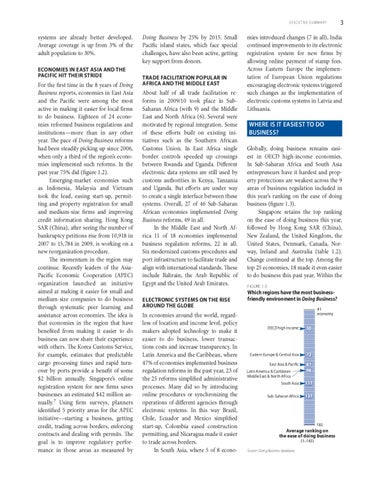EXECUTIVE SUMMARY
systems are already better developed. Average coverage is up from 3% of the adult population to 30%. ECONOMIES IN EAST ASIA AND THE PACIFIC HIT THEIR STRIDE
For the first time in the 8 years of Doing Business reports, economies in East Asia and the Pacific were among the most active in making it easier for local firms to do business. Eighteen of 24 economies reformed business regulations and institutions—more than in any other year. The pace of Doing Business reforms had been steadily picking up since 2006, when only a third of the region’s economies implemented such reforms. In the past year 75% did (figure 1.2). Emerging-market economies such as Indonesia, Malaysia and Vietnam took the lead, easing start-up, permitting and property registration for small and medium-size firms and improving credit information sharing. Hong Kong SAR (China), after seeing the number of bankruptcy petitions rise from 10,918 in 2007 to 15,784 in 2009, is working on a new reorganization procedure. The momentum in the region may continue. Recently leaders of the AsiaPacific Economic Cooperation (APEC) organization launched an initiative aimed at making it easier for small and medium-size companies to do business through systematic peer learning and assistance across economies. The idea is that economies in the region that have benefited from making it easier to do business can now share their experience with others. The Korea Customs Service, for example, estimates that predictable cargo processing times and rapid turnover by ports provide a benefit of some $2 billion annually. Singapore’s online registration system for new firms saves businesses an estimated $42 million annually.7 Using firm surveys, planners identified 5 priority areas for the APEC initiative—starting a business, getting credit, trading across borders, enforcing contracts and dealing with permits. The goal is to improve regulatory performance in those areas as measured by
Doing Business by 25% by 2015. Small Pacific island states, which face special challenges, have also been active, getting key support from donors. TRADE FACILITATION POPULAR IN AFRICA AND THE MIDDLE EAST
About half of all trade facilitation reforms in 2009/10 took place in SubSaharan Africa (with 9) and the Middle East and North Africa (6). Several were motivated by regional integration. Some of these efforts built on existing initiatives such as the Southern African Customs Union. In East Africa single border controls speeded up crossings between Rwanda and Uganda. Different electronic data systems are still used by customs authorities in Kenya, Tanzania and Uganda. But efforts are under way to create a single interface between these systems. Overall, 27 of 46 Sub-Saharan African economies implemented Doing Business reforms, 49 in all. In the Middle East and North Africa 11 of 18 economies implemented business regulation reforms, 22 in all. Six modernized customs procedures and port infrastructure to facilitate trade and align with international standards. These include Bahrain, the Arab Republic of Egypt and the United Arab Emirates. ELECTRONIC SYSTEMS ON THE RISE AROUND THE GLOBE
In economies around the world, regardless of location and income level, policy makers adopted technology to make it easier to do business, lower transactions costs and increase transparency. In Latin America and the Caribbean, where 47% of economies implemented business regulation reforms in the past year, 23 of the 25 reforms simplified administrative processes. Many did so by introducing online procedures or synchronizing the operations of different agencies through electronic systems. In this way Brazil, Chile, Ecuador and Mexico simplified start-up, Colombia eased construction permitting, and Nicaragua made it easier to trade across borders. In South Asia, where 5 of 8 econo-
3
mies introduced changes (7 in all), India continued improvements to its electronic registration system for new firms by allowing online payment of stamp fees. Across Eastern Europe the implementation of European Union regulations encouraging electronic systems triggered such changes as the implementation of electronic customs systems in Latvia and Lithuania.
WHERE IS IT EASIEST TO DO BUSINESS? Globally, doing business remains easiest in OECD high-income economies. In Sub-Saharan Africa and South Asia entrepreneurs have it hardest and property protections are weakest across the 9 areas of business regulation included in this year’s ranking on the ease of doing business (figure 1.3). Singapore retains the top ranking on the ease of doing business this year, followed by Hong Kong SAR (China), New Zealand, the United Kingdom, the United States, Denmark, Canada, Norway, Ireland and Australia (table 1.2). Change continued at the top. Among the top 25 economies, 18 made it even easier to do business this past year. Within the FIGURE 1.3
Which regions have the most businessfriendly environment in Doing Business? #1 economy OECD high income
30
Eastern Europe & Central Asia
72
East Asia & Pacific
87 96
Latin America & Caribbean Middle East & North Africa South Asia
117
Sub-Saharan Africa
137
183
Average ranking on the ease of doing business (1–183) Source: Doing Business database.
